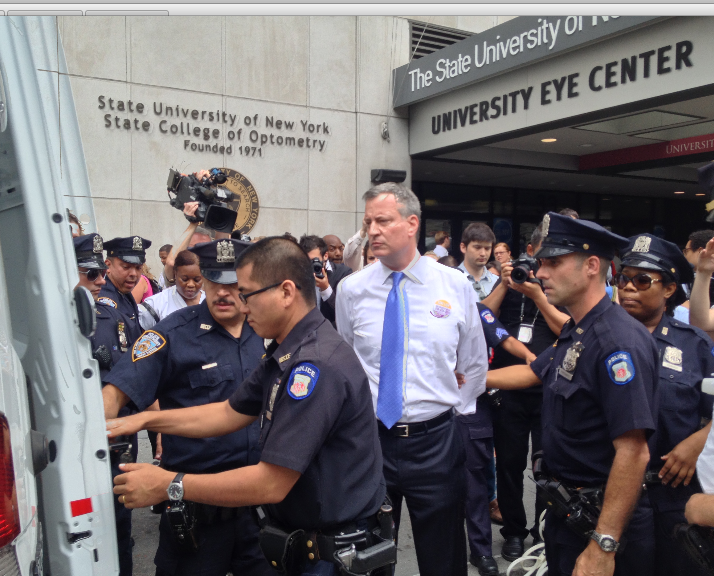
Then-Public Advocate Bill de Blasio is arrested at a LICH protest (photo: Public Advocate's office)
Few swaths of the city have been home to more controversies over the past decade than Brooklyn's 52nd Assembly District. From the creation of Brooklyn Bridge Park and closing of Long Island College Hospital to the prolonged rollout of Atlantic Yards, the area has been nothing if not contested terrain.
Given the various neighborhoods' traditions of civic activism, one might expect to find a lively race to succeed Joan Millman, who in late May announced that she was giving up the assembly seat she held since 1997 in order to take a job with the de Blasio administration.
Instead, the contest is best viewed as the battle of two machines, old vs. new—creating a deficit of democracy in a district where people typically pay more attention to local issues.
A district leader since 2004, Jo Anne Simon is running with the support of both Millman and the Kings County Democratic Party. Frank Seddio, the current party boss, is no kingpin in the tradition of Meade Esposito, and is generally seen as less influential than his predecessor, Vito Lopez (an ally of Seddio but not Simon).
Pete Sikora, meanwhile, represents the new guard, which consists of the Working Families Party, the consultancy BerlinRosen, State Senator Daniel Squadron, and Council Members Brad Lander and Steve Levin. Formerly at NYPIRG, Sikora currently is a lobbyist and legislative director for the communication workers union, a leading player in the WFP.
The third candidate in the race is in the unallied Doug Biviano, a Brooklyn Heights-based activist. That he lacks connections to either machine helps explain why he's less well-funded. Biviano, however, garnered 2500 votes (with only $20k) running against Millman in 2010, suggesting that he can be a factor.
Biviano recently attacked Sikora for his role in the campaign to save LICH. Sikora takes credit for proposing to de Blasio last summer that the then-mayoral candidate and others (including Sikora) get arrested to protest the hospital closing. Sikora told me that he's "very proud" of his role in initiating the act of civil disobedience.
However, many within the area now view de Blasio's high-profile effort as little more than a campaign stunt. BerlinRosen recently circulated a letter defending de Blasio's handling of the LICH closing, an act of damage control by the mayor's team—and one that suggests that the scars won't heal for a while.
As for what to do next at the site, Sikora vows to "fight against high-rise luxury housing," whereas Simon and Biviano are calling for a full-service hospital. Simon also pledges to push for a "Health Care Management Information Act" in Albany that would provide full needs assessments before future hospital closures.
All three candidates are opposed to the high-rise housing (combining luxury and affordable units) proposed for Brooklyn Bridge Park. Simon is proposing that a ferry terminal at Pier 7 could match the revenue for the park that the housing would produce—but the de Blasio administration seems intent on proceeding with its plans.
Simon is also the only one of the three candidates who has been active on Atlantic Yards, of which the WFP was an early supporter. Simon has been a leading figure in Brooklyn Speaks, which sought to stake out the middle ground between Forest City Ratner and Develop Don't Destroy.
Brooklyn Speaks recently claimed success in helping accelerate the pace of affordable housing at Atlantic Yards. While the agreement announced in late June does provide greater accountability, there are major concerns regarding the actual affordability of most of the units—nearly two-thirds of which will go to families earning more than $100,000.
As Simon explains, the issue of actual cost was "outside the scope" of the Brooklyn Speaks' lawsuit, while the gentrification of Prospect Heights has inflated the Area Median Income used to determine the affordability guidelines. Both are valid points, but Simon and Brooklyn Speaks were quick to claim victory despite the fine print.
The real growth area in the district, of course, is Gowanus. While Simon has been a vocal supporter of the SuperFund designation for the site, neither she nor the other two candidates seem to be spelling out a vision for the neighborhood.
It's precisely the need for district residents to hear more from the candidates about their ideas that makes the absence of scheduled debates so conspicuous. At the moment, there's only one on the calendar—hosted by the Prospect Heights Neighborhood Development Council on August 27th. The district only contains a small sliver of that neighborhood.
In the absence of debates, or extensive media coverage, voters will encounter the candidates in traditional fashion: at their doors or on the streets, which places all three contestants on equal footing; and via mailers and robo-calls, which cost money to produce and circulate.
Thus, voters in the 52nd district will be hearing plenty from Sikora and Simon between now and the September 9th primary. Simon has chosen a dubious line of attack, accusing Sikora of inflating his claims regarding his work on NYPIRG's successful effort to win passage of city council lead paint legislation. Fact check: Sikora was at the forefront of that campaign.
In any district, sniping politics-as-usual helps explain the falling rates of voter participation, which increases the power of the machines. And when some of the most engaged voters in the city are being served red herring, it's bad for everyone's health.
***
Theodore Hamm is chair of journalism and new media studies at St. Joseph's College in Clinton Hill, Brooklyn.
Do you have an op-ed idea or submission for Gotham Gazette? Send it to Executive Editor Ben Max: This email address is being protected from spambots. You need JavaScript enabled to view it.